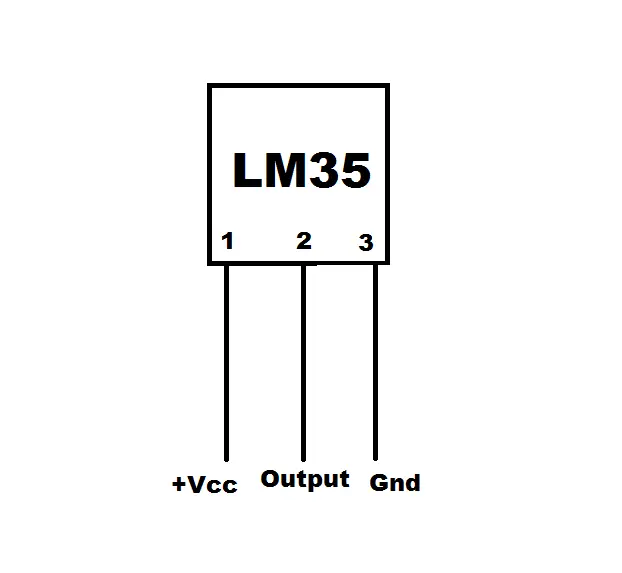Sensors play a vital role in many electronic applications and systems.
They take real world data and then convert it to a voltage which allows our processors like an Arduino to process and analyse it as we choose.
Large applications from power plants to much smaller ones like your toaster will have sensors that make sure that everything runs smoothly.
There exists a multitude of sensors today. You can sense things like force, humidity, pressure, distance, speed, light levels, color and many more.
One important real world parameter that is the most commonly measured is, Temperature.
From simple applications of knowing the temperature outside, so you know how to appropriately dress, to more serious ones like being able to measure your body temperature to ensure you do not have a fever.
The LM35 is a sensor that is capable of measuring temperature.
In this article I will cover in depth, What is a LM35, from how it works to its many applications.
Sensors
Before we dive into the workings of a LM35, I will quickly cover the basics of sensors.
A sensor is a device that detects changes in the real world and then outputs this information to a microcontroller based system such as an Arduino for further processing.
Microcontrollers and other computer processors work with voltages.
What a sensor does is react to changes in the physical world and outputs a voltage to the microcontroller. The microcontroller can then process this information based on different criteria.
The output of the sensor is determined by its input. The sensitivity of a sensor will determine how much the output changes in relation to the input.
Say a temperature sensor operates from 0V to 5V. The voltage at the sensors output will vary proportionally to the temperature being measured.
A sensor by itself is quite redundant. Appropriate systems and processing need to be carried out on the output in order to calculate whatever physical quantity is being measured.
A sensor is composed of integrated circuits, transistors and diodes that are all made up of semiconducting material.
Why we use sensors?
But why do you need to use sensors? Can we live without them?
The answer is no! We cannot live without them.
They provide a valuable service in systems that would not be able to operate without them.
If your air conditioning unit did not have a sensor letting it know what the temperature of the room is, it would not be able to regulate the temperature of that room and you would be either really cold or really hot.
There are 5 reasons why we need sensors; they allow the operation of the system to be smooth and efficient, they keep an eye out for any irregularities, they manage the control of operations, ensure that resources are utilized efficiently and in the case of performance issues make appropriate design changes.
Types of Sensors
There are primarily two types of sensors, Active and Passive.
Active Sensors are a type of sensor that requires an internal energy source to be able to emit radiation.
This type of radiation can be in the form of a light like a laser, infrared radio waves or ultrasonic waves.
This radiation is used to detect objects and changes in the environment.
The radiation is emitted by the sensor and then when it reaches the target object, reflects back to the sensor.
Some common sensors that are active include distance, infrared, and radar.
A distance sensor sends a wave then calculates the time it takes for the wave to hit the target object and reflect back. Since the speed of the wave is known, the distance of the object can then be calculated.
Passive Sensors on the other hand do not produce their own radiation to detect objects or changes in the environment.
They rely on the target object’s radiation. Radiation such as heat or thermal infrared radiation.
An electronic thermometer is an example of a passive sensor as it does not produce its own radiation, rather it relies on your body temperature to detect changes.
Applications
There are so many sensors and applications that I could go on and on about them.
But, for the sake of time I will limit them to the most common applications.
All of these applications that I am going to list would not be able to function without sensors.
Automotive
The Automotive industry uses sensors in many areas from braking and traction control, air bags, avoiding collisions, comfort and engine data.
Manufacturing
Manufacturing is a wide field and covers things like maintenance of machinery, monitoring performance of machinery, fine tuning quality systems, and reacting to market demands.
Aviation
Flying is a dangerous undertaking and requires systems to help you get from one destination to another.
Applications of sensors in aviation include navigation, measuring engine pressure and oil/fuel, weather conditions, speed of the aircraft, and many more.
Medical
Having the right equipment can be the difference between life and death.
Here are a few uses of sensors in the medical field; monitoring blood pressure, glucose levels, patients vitals, detection of diseases spread by visitors to patients and robotics in the operation theater.
LM35
So now that we have a better understanding of what sensors are, and the different types of sensors and their applications, let us dive into what is a LM35.
The LM35 is a sensor that measures temperature. The Prefix LM stands for Linear Monolithic.
Temperature is an important parameter that is commonly measured. From weather systems, to air conditioning units, temperature sensors are an essential part of everyday life.
The LM35 can measure the temperature of its surroundings, or, whatever object it is connected to.
Temperature sensors come in two forms; Contact and Non-Contact.
Non-Contact
Non-contact temperature sensors do not require physical connection to the object it is trying to measure the temperature off. Rather it measures the temperature given off by the radiation of that object.
Contact
Contact temperature sensors are further categorised into 3 sub-categories; Electromechanical, Resistance Temperature Detectors and Semiconductor based.
Electromechanical temperature sensor works almost like a switch. It contains two metals that could be nickel, copper, tungsten or aluminium. These two metals are bonded together to form what is known as a Bi-metallic strip.
Since the two metals have different expansion rates, when the two metals are subjected to an increase in temperature, they bend.
This way they act as a switch either allowing or preventing the flow of current.
The most common electromechanical sensor is the Thermostat.It was used in applications to control heating elements in boilers, furnaces and vehicle radiator cooling systems.
However, they are pretty outdated and not used that much anymore.
Resistance Temperature Detectors determine temperature of a wire that is wound around a ceramic or glass.
The wire is a pure material that has a relationship between its resistance and temperature that is very accurate. Therefore, temperature can be calculated using the right mathematical formulas.
Semiconductor based temperature sensors are aptly named that because they function using semiconductors. They come in the form of an integrated circuit.
Semiconductors are mainly composed of the material silicon. Silicon is a great material as it is widely available, easy to use, have the right characteristics and are cheap.
So what category of temperature sensors does the LM35 fall into?
The LM35 is a semiconductor based sensor. It is low cost and readily available among other temperature sensors.
How the LM35 works
The LM35 is a temperature sensor whose electrical output is proportional to the temperature in degrees celsius.
It is a linear device which means that the voltage at the output of the LM35 increases proportionally to the temperature.
This relationship is 10mv/°C. This means that everytime the temperature increases by one degree, the voltage at the output of the LM35 increases by 10mV (0.10V).
So, if you were at room temperature, which is generally 25°C, the output of the LM35 would be 250mV or 0.25V.
So, you can see how easy it is to calculate the temperature. It is just a matter of multiplying the output voltage of the LM35 by 100.
Also, the LM35 does not require any form of calibration to attain this accuracy. It is ready to use as soon as you receive it.
And, because of the output impedance, and accurate calibration, interfacing to control circuits is easy. I shall cover interfacing below.
Features
Below is the pinout of the LM35:

As I mentioned above the LM35 is calibrated in degree Celsius, and has a linear scale factor of 10mv/°C.
Though the output is in degree celsius, you can still obtain the temperature in Fahrenheit by using a Celsius to Fahrenheit formula.
Below are other important features to note
- It can sense temperatures ranging from -55°C to 150°C
- It has an accuracy of 0.5°C
- Low cost
- Its operating voltage is 4V to 30V
- It draws current less than 60mA
- Low impedance output
Interfacing
The LM35 is a standalone device. What this means is that you cannot just hook up its output to a display and expect to see the temperature.
It requires control circuitry that can perform calculations to obtain the temperature and then display it on something like an LCD (Liquid Crystal Display)..
The output needs to be connected to an Analog to Digital Converter (ADC) of a microcontroller based module such as an Arduino (or even just a standalone microcontroller).
Without getting into too much detail, the ADC of the microcontroller converts the output voltage of the LM35 (which is analog) to a digital form (represented in binary).
Since the LM35 does not require any extra circuitry,interfacing the LM35 to a microcontroller is as simple as connecting its output to the ADC input pin of the microcontroller.
Different types of packaging
Packaging of sensors come in a variety of options. These options include TO-CAN, TO-92, SOIC, TO-220 and many more.
If you want an in-depth look at all the different types of packaging of components you can find them here.
When it comes to the packaging of the LM35 series of temperature sensors, there are multiple choices available at your disposal listed below
- TO-CAN (3 pin) —> 4.699 mm x 4.699 mm
- TO-92 (3 pin) —> 4.30 mm x 4.30 mm
- SOIC (8 pin) —> 4.90 mm x 4.90 mm
- TO-220 (3 pin) —> 14.986 mm x 10.16 mm
Advantages
The LM35 is a great option for Hobbyists, students and DIY projects because it has so many great benefits and advantages that will benefit these applications.
The first main advantage is, ease of use. You do not need any extra circuitry to get the LM35 working. Even if you do not have a control circuit, you can still power up the LM35 and read its output using a multimeter to calculate the temperature.
No calibration is needed. You can use the LM35 as soon as you unpackage it. No need for trimming or calibrating it, as it is ready to go. Just plug and play.
Since the relationship between the voltage and temperature is proportional, calculating the temperature is as simple as multiplying the output by a factor of 100.
Cost. The LM35 is cheap and readily available. So, for hobbyists or students who want to save on money, it is your best friend.





